| |
|
Xiamen Oil Paintings, Wholesale Direct!
|
|
100% hand painted, 100% cotton canvas, 100% money back if not satisfaction. |
|
|
|
|
ART WORKS INDEX
A
B
C
D
E
F
G
H
I
J
K
L
M
N
O
P
Q
R
S
T
U
V
W
X
Y
Z
|
|
ARTISTS INDEX
A
B
C
D
E
F
G
H
I
J
K
L
M
N
O
P
Q
R
S
T
U
V
W
X
Y
Z
|
|
|
|
|
|
|
|
 |
Ferdinand Kobell
|
|
(born in Mannheim, 7 June 1740; died in Munich, 1 February 1799) was a German painter and engraver.
He was studying at the University of Heidelberg when the Elector of Bavaria, admiring a landscape, aided him to devote his entire time to painting. He became the pupil of Peter Verschaffelt. He next studied art in Paris (1768-1769). On his return, he was appointed painter to the Cabinet (court painter), and later professor at the Academy. In 1793, he moved to Munich. He was appointed director of the Mannheim Gallery (1798) but died before entering on his duties.
|
|
 |
Ferdinand Keller
|
|
Ferdinand Keller (born 5 August 1842 in Karlsruhe; died 8 July 1922 in Baden-Baden) was a German painter.
|
|
 |
Ferdinand Hodler
|
|
1853-1918
Swiss Ferdinand Hodler Galleries
Hodler was born in Berne and grew up in poverty. His father, Jean Hodler, made a meager living as a carpenter; his mother, Marguerite (n??e Neukomm), was from a peasant family. By the time Hodler was eight years old, he had lost his father and two younger brothers to tuberculosis. His mother remarried to a decorative painter, but in 1867 she too died of tuberculosis. Before he was ten, Hodler received training in decorative painting from his stepfather, and was subsequently sent to Thun to apprentice with a local painter, Ferdinand Sommer. Hodler's earliest works were conventional landscapes, which he sold in shops and to tourists. In 1871, at the age of 18, he traveled on foot to Geneva to start a career as a painter.
The works of Hodler's early maturity consisted of landscapes, figure compositions and portraits, treated with a vigorous realism. He made a trip to Basel in 1875, where he studied the paintings of Hans Holbein??especially Dead Christ in the Tomb, which influenced Hodler's many treatments of the theme of death. In the last decade of the 19th century his work evolved to combine influences from several genres including symbolism and art nouveau. He developed a style which he called Parallelism, characterized by groupings of figures symmetrically arranged in poses suggesting ritual or dance.
In 1884 Hodler met Augustine Dupin (1852?C1909), who became his companion and model for the next several years. Their son, Hector Hodler, was born in 1887. In 1889 Hodler married Bertha Stucki; they were divorced in 1891.
Hodler's work in his final phase took on an expressionist aspect with strongly coloured and geometrical figures. Landscapes were pared down to essentials, sometimes consisting of a jagged wedge of land between water and sky. However, the most famous of Hodler's paintings portray scenes in which characters are engaged in everyday activities, such as the famous woodcutter (Der Holzfaller, Mus??e d'Orsay, Paris). This picture went on to appear on the back of the 50 Swiss Franc bank note issued by the Swiss National Bank.
In 1898, Hodler married Berthe Jacques. In 1914 he condemned the German atrocities conducted using artillery at Rheims. In retaliation for this, German art museums excluded Hodler's work.
In 1908 he met Valentine Gode-Darel, who became his mistress. She was diagnosed with cancer in 1913, and the many hours Hodler spent by her bedside resulted in a remarkable series of paintings documenting her disintegration. Her death in January 1915 affected Hodler greatly. He occupied himself with work; a series of about 20 introspective self-portraits date from 1916. By late 1917 his declining health led him to thoughts of suicide. He died on May 19, 1918 in Geneva leaving behind a number of unfinished works portraying the city.
|
|
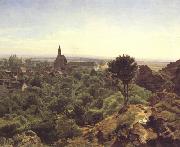 |
Ferdinand Georg Waldmuller
|
|
Austrian Romantic Painter, 1793-1865
was an Austrian painter and writer. He briefly attended the Academy of Fine Arts Vienna, however later had to finance his life by painting portraits. In 1811 he got a job as a teacher of arts for the children of Count Gyulay in Croatia. After 3 years he returned to Vienna and started to improve his skills by copying the works of old masters. Waldmeller later became interested in nature and thus started painting landscapes (genre painting). His most notable work lies in the depiction of nature, where his sense for colours and large knowledge of nature helped him to achieve masterly skills. In 1823 he made a painting of Ludwig van Beethoven. He was professor at the Academy of Fine Arts Vienna,
|
|
 |
Ferdinand bol
|
|
Dutch Baroque Era Painter, 1616-1680
Dutch painter and draughtsman. He was a pupil and prominent follower of Rembrandt in Amsterdam. His reputation and fame are based on his history paintings, which, though successful at the time,
|
|
|
|
|
|
 |
Felix Ziem
|
|
French Painter, 1821-1911
was a French painter in the style of the Barbizon School. Born Felix-Francois Georges Philibert Ziem in Beaune in the Côte d'Or departement of the Burgundy region of France, his mother was a native of Burgundy who married a Croatian immigrant. Originally, Ziem planned to be an architect and studied at the School of Architecture in Dijon, and for a time worked as an architect. Painting developed from a hobby to a career following an 1841 visit to Italy where he fell in love with the city of Venice, a place that would become the source for many of his works. Apart from Venetian scenes, he also painted many still lifes, portraits and landscapes from a variety of places including Constantinople, Martigues, Cagnes-sur-Mer and his native Burgundy. Ziem's works were first exhibited in 1849 at the Paris Salon and remained a regular exhibitor there for many years. Part of the Barbizon school, he also traveled extensively throughout Europe and in 1860 moved to Montmartre, the artistic quarter of the city of Paris. Financially successful, he was known to assist struggling young artists. In 1857, the government of France recognized his contribution to the art world by making him a Chevalier of the Legion of Honor.
|
|
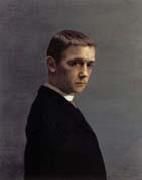 |
Felix Vallotton
|
|
1865-1925was a Swiss painter and printmaker associated with Les Nabis. He was an important figure in the development of the modern woodcut. He was born into a conservative middle class family in Lausanne, and there he attended College Cantonal, graduating with a degree in classical studies in 1882. In that year he moved to Paris to study art under Jules Joseph Lefebvre and Gustave Boulanger at the Academie Julian. He spent many hours in the Louvre, where he greatly admired the works of Holbein, Derer and Ingres; these artists would remain exemplars for Vallotton throughout his life.[1] His earliest paintings, such as the Ingresque Portrait of Monsieur Ursenbach (1885), are firmly rooted in the academic tradition, and his self portrait of 1885 (seen at right) received an honorable mention at the Salon des artistes français in 1886. During the following decade Vallotton painted, wrote art criticism and made a number of prints. In 1891 he executed his first woodcut, a portrait of Paul Verlaine. The many woodcuts he produced during the 1890s were widely disseminated in periodicals and books in Europe as well as in the United States, and were recognized as radically innovative in printmaking. They established Vallotton as a leader in the revival of true woodcut as an artistic medium; in the western world, the relief print, in the form of commercial wood engraving, had long been mainly utilized unimaginatively as a medium for the reproduction of drawn or painted images and, latterly, photographs. Vallotton's starkly reductive woodcut style features large masses of undifferentiated black and areas of unmodulated white. While emphasizing outline and flat patterns, Vallotton generally made no use of the gradations and modeling traditionally produced by hatching. The influences of post-Impressionism, symbolism and the Japanese woodcut are apparent; a large exhibition of ukiyo-e prints had been presented at the École des Beaux-Arts in 1890, and Vallotton, like many artists of his era an enthusiast of Japonism, collected these prints. He depicted street crowds and demonstrations including several scenes of police attacking anarchists bathing women, portrait heads, and other subjects which he treated with a sardonic humor. His graphic art reached its highest development in Intimit's (Intimacies), a series of ten interiors published in 1898 by the Revue Blanche, which deal with tension between men and women. Vallotton's prints have been suggested as a significant influence on the graphic art of Edvard Munch, Aubrey Beardsley, and Ernst Ludwig Kirchner .By 1892 he was affiliated with Les Nabis, a group of young artists that included Pierre Bonnard, Ker-Xavier Roussel, Maurice Denis, and Edouard Vuillard, with whom Vallotton was to form a lifelong friendship. During the 1890s, when Vallotton was closely allied with the avant-garde, his paintings reflected the style of his woodcuts, with flat areas of color, hard edges, and simplification of detail.
|
|
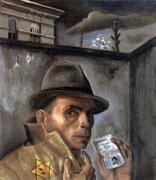 |
Felix Nussbaum
|
|
1904-44
Nussbaum was born in Osnabreck, Province of Hanover, as the son of Rahel and Phillip Nussbaum. Phillip was a World War I veteran and German patriot before the rise of the Nazis. He was an amateur painter when he was younger, but was forced to pursue other means of work for financial reasons. He therefore encouraged his son's artwork passionately. Nussbaum was a lifelong student, beginning his formal studies in 1920 in Hamburg and Berlin and continuing as long as the current political situation allowed him. In his earlier works, Felix was heavily influenced by Vincent Van Gogh and Henri Rousseau and he eventually pays homage to Giorgio de Chirico and Carlo Carre as well. Carl Hofer's expressionist paineng influenced Felix's careful approach color. In 1933, Nussbaum was studying on scholarship in Rome at the Berlin Academy of the Arts when the Nazis gained control of Germany.
|
|
 |
felix mendelssohn
|
|
Period: Romantic (1820-1869)
Country: Germany
Born: February 03, 1809 in Hamburg, Germany
Died: November 04, 1847 in Leipzig, Germany
|
|
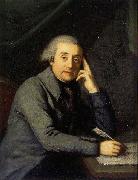 |
Felix Maria Diogg
|
|
(b Andermatt, 1 July 1762; d Rapperswil, Schwyz, 19 Feb 1834). Swiss painter. From 1782 he was a pupil of Johann Melchior Wyrsch in Besanion, under whom he developed the essential aspects of his portrait style. He also studied further in Rome and Naples from 1786 to 1788. He was capable of executing bright, incisive portraits in the manner of Angelica Kauffman, as in Portrait of an Artist or psychological studies, best seen in Ulysses von Salis-Marschlins. Several of his group portraits, such as the Esslinger Family, show the influence of Italian and British painting, with which he seemed to be familiar. He was a friend of Johann Kaspar Lavater, discoursed with Goethe and enjoyed the company of the Swiss historian Johannes von Miller (1752-1809), whose portrait he painted. His portraits are generally bust-length types set against a solid, dark background. This format was favoured by his Swiss clientele and is seen in Burgomaster Heinrich Krauer (1799; Lucerne, Kstmus.), which also reveals the dignified wooden pose frequently selected by his models. His direct, fashionable treatment of the sitter attracted a wide range of clients from all levels of society. He seemed to be as much at ease painting the Empress of Russia, Yelisaveta Alekseyevna (1814; Karlsruhe, Staatl. Ksthalle) as he was portraying the bourgeoisie of central Switzerland.
|
|
|
|
|
|
 |
Felix Esterl
|
|
(1894 -1931 ) - Painter
painted Still life with fruits, foliage plants and jug in
|
|
|
|
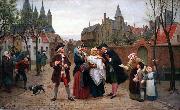 |
Felix de Vigne
|
|
(16 March 1806 - 5 December 1862) was a Belgian painter.
De Vinge was a history painter, engraver, art historian, and instructor at the Royal Academy of Fine Arts (Ghent). In 1847 he published Recherches historiques sur les costumes civils et militaires, an illustrated compendium of the flags, shields and costumes of medieval guilds and military groups.
He was the brother of sculptor Pieter De Vigne (1812-1877), father of Brussels architect Edmond De Vinge (1841-1918), and the stepfather of painter Jules Breton.
|
|
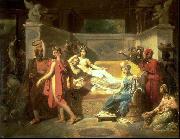 |
Felix Auvray
|
|
a French historical painter, was born at Cambrai in 1800. He was a pupil of Momal in Valenciennes, and afterwards of Gros in Paris. He exhibited in 1824, 'St. Louis a Prisoner,' and in 1827, 'Gautier de Châtillon defending St. Louis against the Saracens,' now in the Museum of Cambrai; 'St. Paul at Athens,' &c. He died in 1833, in his native city.
|
|
 |
Felix Vallotton
|
|
French
1865-1925
Felix Vallotton Gallery
Swiss woodcut artist and painter. Associated with the Nabis, he worked in Paris. Vallotton rejuvenated the woodcut medium as a creative technique. His boldly cut designs, conceived as arrangements in black and white, depict Parisian society with wit and intelligence. A painting, Swiss Landscape, is in the Lyman Allyn Museum, New London,
|
|
|
|
 |
Felicien Rops
|
|
Belgian Symbolist Engraver, 1833-1898
was a Belgian artist, and printmaker in etching and aquatint. Rops was born in Namur in 1833, and was educated at the University of Brussels. Rops's forte was drawing more than painting in oils; he first won fame as a caricaturist. He met Charles Baudelaire towards the end of Baudelaire's life in 1864, and Baudelaire left an impression upon him that lasted until the end of his days. Rops created the frontispiece for Baudelaire's Les Épaves, a selection of poems from Les Fleurs du mal that had been censored in France, and which therefore were published in Belgium. Rops's association with Baudelaire and with the art he represented won his work the admiration of many other writers, including Theophile Gautier, Alfred de Musset, St phane Mallarm, Jules Barbey d'Aurevilly, and Josephin Peladan. He was closely associated with the literary movement of Symbolism and Decadence. Like the works of the authors whose poetry he illustrated, his work tends to mingle sex, death, and Satanic images.
|
|
 |
Felice Giani
|
|
Italian Neoclassical Painter, ca.1758-1823,Italian painter and draughtsman. He was a prolific painter who, with a team of artists and craftsmen, decorated palaces and public buildings in Rome, Venice, many cities in Emilia Romagna (especially Faenza), and in France. He worked in a distinctive Neo-classical style, creating sumptuous, richly coloured rooms, the paintings on walls and ceilings being surrounded with a wealth of antique ornament. Despite the turbulent era of revolution and war (1789-1815) he never lacked commissions, for which he chose subjects from the literature and history of Greece and Rome that were symbolic both for him and for his patrons. He was a prodigiously talented draughtsman, who drew constantly,
|
|
 |
Felice Ficherelli
|
|
Italian painter , b. 1603, San Gimignano, d. 1660, Firenze
Firenze,Italian painter. His most original works were easel pictures, for private collectors, often of cruel and violent subjects, which he interpreted with a morbid sensuality and ambiguous tenderness. He was brought to Florence when very young by the collector Conte Alberto Bardi (d 1632), who arranged for him to study with Jacopo da Empoli and to copy works by Andrea del Sarto. Ficherelli's clear compositions and luminous drapery, which remain evident throughout his career, reflect this training. In the early 1630s he was attracted by the delicate sfumato effects of Francesco Furini and developed a style close to that of Cecco Bravo; his works of this period include the Sacrifice of Isaac (Florence, priv. col., for illustration see Gregori, 1968, p. 26) and the Martyrdom of St Agatha (priv. col., see Cantelli, fig. 338). There followed in the late 1630s Tarquin and Lucretia, which is known in several versions (e.g. Rome, Accad. N. S Luca), the theatrical Julia Receiving the Bloodstained Garments of Pompey (Genoa, priv. col., see 1986 exh. cat., pl. 1.208), an Allegory of Patience (Florence, Bigongiari priv. col., see Gregori, 1974, fig. 23) and Antiochus and Stratonica (Auckland, C.A.G.).
|
|
|
|
|
|
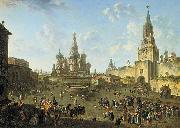 |
Fedor Yakovlevich Alekseev
|
|
Fedor Yakovlevich Alekseev Russian: (c. 1753 - November 23, 1824) was an early Russian painter of landscape art.
After training in the Saint Petersburg Imperial Academy of Arts, he spent three years in Venice studying the works of famous French and Italian landscape painters.
Returning to Saint Petersburg to work, his popularity grew over time. In 1800, Emperor Paul of Russia commissioned a series of paintings of Moscow from him.
|
|
|
|
 |
Fedor Rokotov
|
|
Russian Painter, ca.1735-1808
Fyodor Stepanovich Rokotov (Fedor Rokotov) (Russian: ?????????? ??????????́?????????? ????́??????????) (1736?C1809) was a distinguished Russian painter who specialized in portraits.
Fyodor Rokotov was born into a family of peasant serfs, belonging to the Repnins. Much in his biography is obscure. He studied art in Saint Petersburg Academy of Arts. After buying back his freedom in the end of 1750s he became established as a fashionable painter.
In 1765, Rokotov was elected an Academician, but he did not work as a professor in the Academy long, because it interfered with his painting. He returned to Moscow in 1765, where he lived for the rest of his life. He had a lot of commissions there, becoming one of the best portrait painters of his time.
Among his best-known portraits are Portrait of Alexandra Struyskaya (1772), sometimes called the Russian Mona Lisa and admittedly the most celebrated piece of the 18th-century Russian painting; Portrait of Countess Elisabeth Santi (1785), and Lady in a Pink Dress (1770s, illustration, right).
Rokotov avoided painting formal portraits with lots of adornments and decorations. Instead he was one of the first Russian painters advancing a psychological portrait with attention to optical and atmospheric effects.
|
|
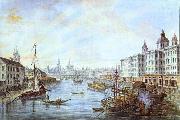 |
Fedor Alekseev
|
|
(c. 1753 ?C November 23, 1824) was an early Russian painter of landscape art.
After training in the Saint Petersburg Imperial Academy of Arts, he spent three years in Venice studying the works of famous French and Italian landscape painters.
Returning to Saint Petersburg to work, his popularity grew over time. In 1800, Emperor Paul of Russia commissioned a series of paintings of Moscow from him.
|
|
 |
Federico zandomeneghi
|
|
Italian Painter, 1841-1917
.Italian painter. His father Pietro and grandfather Luigi tried to interest him in the plastic arts, but from a very early age he showed a stronger inclination for painting. Zandomeneghi soon rebelled against their teachings, and by 1856 he was attending the Accademia di Belle Arti in Venice, studying under the painters Michelangelo Grigoletti (1801-70) and Pompeo Molmenti (1819-94). As a Venetian he was born an Austrian subject, and, to escape conscription, he fled his city in 1859 and went to Pavia, where he enrolled at the university. In the following year he followed Garibaldi in the Expedition of the Thousand; afterwards, having been convicted of desertion and therefore unable to return to Venice, he went to Florence, where he remained from 1862 to 1866. This period was essential for his artistic development. In Tuscany he frequented the Florentine painters known as the Macchiaioli, with some of whom he took part in the Third Italian War of Independence (1866). Zandomeneghi formed a strong friendship with Telemaco Signorini and Diego Martelli, with whom he corresponded frequently for the rest of his life. In this period he painted the Palazzo Pretorio of Florence
|
|
|
|
|
|
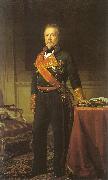 |
Federico de Madrazo y Kuntz
|
|
1815-1894
Spanish
Federico de Madrazo y Kuntz Gallery
Born in Rome, he was the son of the painter Madrazo y Agudo (1781-1859), and received his first instruction from his father. While still attending the classes at the Royal Academy of San Fernando, he painted his first picture, The Resurrection of Christ (1829), which was purchased by Queen Christina. Not long afterwards he painted Achilles in his Tent, and subsequently presented to the Academy The Continence of Scipio, which secured him admission as a member "for merit".
While decorating the palace of Vista Alegre he took up portraiture. In 1852 he went to Paris, where he studied under Franz Winterhalter, and painted portraits of Baron Taylor and Ingres. In 1837 he was commissioned to produce a picture for the gallery at Versailles, and painted "Godfrey de Bouillon proclaimed King of Jerusalem". The artist then went to Rome, where he worked at various subjects, sacred and profane. Then he painted Maria Christina in the Dress of a Nun by the Bedside of Ferdinand III (1843), Queen Isabella, The Duchess of Medina-Coeli, and The Countess de Vilches (1845-1847), besides a number of portraits of the Spanish aristocracy, some of which were sent to the exhibition of 1855.
He received the Legion of Honour in 1846. He was made a corresponding member of the Paris Academy of Fine Arts on 10 December 1853, and in 1873, on the death of Schnorr, the painter, he was chosen foreign member. After his father's death he succeeded him as director of the Museo del Prado and president of the Academy of San Fernando. He originated in Spain the production of art reviews and journals, such as El Artiste, El Renacimiento, and El Semanario pintoresco. He died at Madrid in 1894.
|
|
|
|
 |
Fede Galizia
|
|
(1578 - 1630) was an Italian Renaissance painter, a pioneer of the still life genre.
Fede Gallizi, better known as Galizia, was born in Milan in 1578. Her father, Nunzio Galizia, also a painter of miniatures, had moved to Milan from Trento. Fede (whose name means "faith") learned to paint from him. By the age of twelve, she was sufficiently accomplished as an artist to be mentioned by Gian Paolo Lomazzo, a painter and art theorist friend of her father, who wrote, "This girl dedicates herself to imitate our most extraordinary art."
At a young age, Fede was already an established portrait painter handling many commissioned works. Perhaps it was her father's influence as a miniaturist that led to Fede's attention to detail in her portraits. Her treatment of jewels and clothing made her a very desirable portrait painter. She was often commissioned to paint religious and secular themes as well. Several of her paintings based on the deuterocanonical story of Judith and Holofernes, a popular theme in art of the period, survive in private collections. Perhaps her earliest was Judith and Her Handmaiden painted in 1596 which is now in Sarasota Florida at the Ringling Museum of Art. She also created miniatures and altarpieces for convents.
|
|
|
|
 |
FASOLO, Bernardino
|
|
Italian painter, Genovese school (b. ca. 1489, Pavia, d. after 1526, Genova)
|
|
 |
FARINATI, Paolo
|
|
Italian painter, Veronese school (b. 1524, Verona, d. 1606, Verona)
Italian painter and draughtsman. He was the son of a painter, Giambattista, but probably trained in the workshop of Nicola Giolfino (Vasari). His earliest documented painting, St Martin and the Beggar (1552; Mantua Cathedral), was commissioned by Cardinal Ercole Gonzaga along with works by Battista dell'Angolo del Moro, Veronese and Domenico Brusasorci for Mantua Cathedral, newly restored by Giulio Romano. As is evident in his chiaroscuro and figure types, Farinati had absorbed certain Mannerist influences from the frescoes of scenes from the Life of the Virgin (1534) in the choir of Verona Cathedral, executed by Francesco Torbido to Giulio's design. Giolfino's eccentric style would also have encouraged Farinati to emphasize line over colour and to restrict his palette to rather opaque greys, browns, mauve and rust. His two-canvas Massacre of the Innocents (1556; Verona, S Maria in Organo) displays the muscular figures, sharp foreshortenings and posed attitudes of Mannerism and has a more polished finish than his earlier work. Its strong, plastic qualities are also evident in Christ Walking on the Water and the Supper of St Gregory (1558) in the choir of the same church.
|
|
 |
Fanny Palmer
|
|
One of the premier artists and stone lithographers .
American , 1812-1876
|
|
|
|
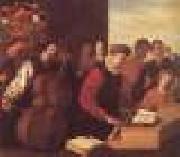 |
FALCONE, Aniello
|
|
Italian painter, Naples school (b. 1607, Napoli, d. 1656, Napoli).
Italian painter and draughtsman. He trained briefly with Jusepe de Ribera, the Caravaggesque Spanish painter. He quickly won fame as a specialist in scenes of battle, and his contemporaries nicknamed him the 'oracle' of this genre. Falcone created the 'battle scene without a hero' (Saxl): he showed the battle as a brutal, confused struggle between anonymous troops, without heroes, without defeats and without particular historical incidents. The Battle between Turks and Christians (1621; Paris, Louvre; see fig.) is one of the earliest. The frieze-like composition is elaborately structured, yet the picture is rich in intensely naturalistic, vividly coloured details of armour and weapons and precisely observed expressions of anger and pain. The famous dealer and collector Gaspar Roomer and other Neapolitan collectors commissioned many battle pictures from him, and these were soon introduced throughout Europe. He was especially favoured by Ferrante Spinelli, Prince of Tarsia, who gave Falcone a residence in his palace after 1651.
|
|
|
|
 |
FABRITIUS, Carel
|
|
Dutch Baroque Era Painter, 1622-1654
Painter. His oeuvre consists of a scant dozen paintings, since research has rigorously discounted many previously attributed works. These few paintings, however, document the painter's unique development within his brief 12-year career. He is often mentioned as being the link between Rembrandt and the Delft school, particularly Pieter de Hooch and Jan Vermeer, whose depiction of light owes much to Fabritius's late works in which his use of cool silvery colours to define forms in space marks a radical departure
|
|
|
|
|
|
|
|
|
|
|
|
|
|
|
|
|
|
|
| Wholesale China Oil Painting Wholesale Oil Painting China Xiamen Portrait Reproduction on canvas Chinese Oil Painting Wholesale USA Oil Painting |
|
|
|
|
|